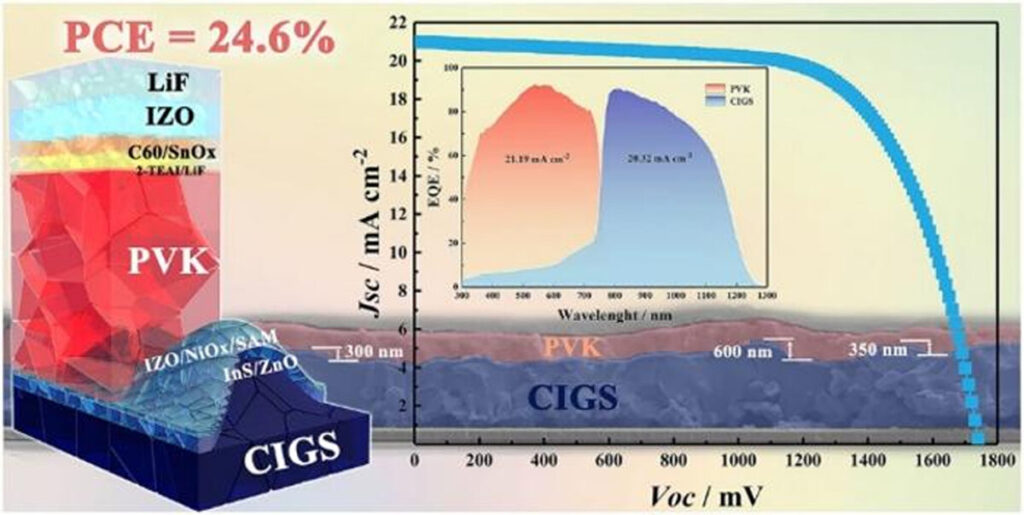Chinese scientists touch 24.6% efficiency with a two-terminal perovskiet-cigs tandem cell by adding D-homoserine Lactonhydrochloride (D-HLH) to the Perovskiet prospect, who marks one of the highest reported performance for technology.
Image: Cong Geng, Kuanxiang Zhang, Changhua Wang, Chung Hsien Wu, Jiwen Jiang, Fei Long, Liyuan Han, Qifeng Han, Yi-Bing Cheng, Yong Peng
Scientists from Shanghai Jiao Tong University and Wuhan University of Technology have manufactured a two-terminal (2T) tandem solar cell with the help of a top semi-transparent perovskiet layer and a bottom copper-Indium-Indium-gallium-selenide (CIGS) cell.
They reported improved perovskiet coverage on the rough, irregular surfaces of commercial CIGS substrates and reduced bulk defects-long challenges for perovskiet-cigs tandem cells. The team said that these surface functions have hindered historically effective integration and limited performance.
Researchers used D-Homoserin Lactonhydrochloride (D-HLH) as an additive in the Perovskietloper to improve the crystallization of the absorbent layer. This reportedly reduced film defects made a more uniform coverage possible and improved the interface between the perovskiet and CIGS layers.
The group also relates to interface combination between the perovskietabsorber and the Buckminsterfullerene (C60) electron transport layer, where incomplete passivating vessels of minority carriers. They brought a double passion approach that combines surface reconstruction and field effect passivation.
“The surface reconstruction includes the use of 2-thiopheen ethylammonium iodide (2-teai) and N, N-Dimethylformamide (DMF), which effectively passivates the defect places on the PVK surface and grain boundaries,” they explained. “Meanwhile, lithium fluoride (LIF) is being introduced as a field effect passivating layer, which repels hole wearers from the perovskiet/C60 interface, which reduces the recombination losses.”
According to these two strategies, the researchers built the upper perovskiet machine using a substrate of IndiumTin-Tinoxide (ITO), a nickel (II) oxide (NIOX) hole transport layer (HTL), a 2Pacz-based self-assembled monolayer, a c60-eighter-abbeasite Transparent Indium Zincie (IZO), a transparent indium zincie (IZO), a transparent indium zincie (IZO), a transparent indium zincie (IZO), a transparent indium zincie (IZO), a transparent indium zincie (IZO), a tranparent, an IZO), a tranparent, a transparent), a transparent (IZO), a transparent (IZO), a transparent (IZO), a tranpie), a tranparpie), a transparent (IZO), a tranpie), a tranparent (IZO), a tranpie), a transparent (izo), tranium (IZO), a tranparpie), a tranparpie (IZO). Zincie (IZO), a transparent indium zincie (IZO), a transparent indium-zinc-zinc oxide (IZO) interlayer and a silver (AG) metal contact.
The device achieved a power conversion efficiency of 19.1%, compared to 17.9% for a reference perovskite solar cell with the same architecture but without D-hlh or the double passivation strategy. The researchers said they achieved an average efficiency above 21.8% with a combination of 2-teai and Lif, which demonstrated the effectiveness of the double passion approach.
They then integrated the perovskiet cell with a soil -cigs cell into a tandem device of 0.16 cm² that achieved 24.6% power conversion -efficiency.
“The realization of both bulk and surface/interface passivation through the combined use of D-hlh, 2-teai and LIF has limited PVK crystallization and complex interface-carrier-recombination problems,” concluded it.
The tandem cell was described in the study “Crystallization modulation and holistic passivation make efficient two-termal perovskiet/cuin (GA) SE possible2 Tandem solar cells“Which was recently published in Nano-Micro Letters.
This content is protected by copyright and may not be reused. If you want to work with us and reuse part of our content, please contact: editors@pv-magazine.com.

